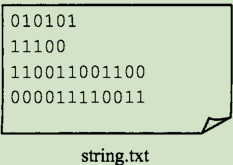如果两个字符串中0和1的个数分别相等,则称该对字符串为相等。
方法一:
由于string类对于读取文件中子串以及比较都很方便,所以,用string类的对象来逐对存放字串,然后将字串分别排序后对其进行比较是直接的思路。

1 #include<iostream> 2 #include<fstream> 3 #include<algorithm> 4 using namespace std; 5 6 int main() 7 { 8 ifstream in("string.txt"); 9 for (string s, t; in >> s >> t;) 10 { 11 sort(s.begin(),s.end); 12 sort(t.begin(),t.end); 13 cout << (s==t?"yes ":"no "); 14 } 15 }

程序中用到了算法sort调用,所以要包含算法库头文件algorithm。
方法二:
基本的排序算法需要对所有元素进行两重循环的操作,最快的排序算法也需要O(nlogn)数量级的运算次数,然而,如果仅对字串分别数一下1和0的个数,再比较其个数值,效率会更高:
1 #include<iostream> 2 #include<fstream> 3 #include<algorithm> 4 using namespace std; 5 6 int main() 7 { 8 ifstream in("string.txt"); 9 for (string s, t; in >> s >> t;) 10 { 11 int sc1 = count(s.begin(), s.end(),'1'); 12 int sc0 = count(s.begin(), s.end(), '0'); 13 int tc1 = count(t.begin(), t.end(), '1'); 14 int tc0 = count(t.begin(), t.end(), '0'); 15 cout << (sc1==tc1&&sc0==tc0?"yes ":"no "); 16 } 17 }
count计数也包含在C++标准库中,由于count算法只有一重循环的处理时间,虽然程序中有4次count调用,但比较排序算法,对于元素个数激增时,其效率能明显体现出来。当然有些读者可能看到了还能对其做进一步优化:count算法是线性的,无论如何,一重循环是不可避免的。
方法三:
根据问题描述,字串中非1即0, so,“0”的个数在总长度已知的情况下,可以不使用count算法,通过并列地判断总长度的相等性而直接得到:
1 #include<iostream> 2 #include<fstream> 3 #include<algorithm> 4 using namespace std; 5 6 int main() 7 { 8 ifstream in("string.txt"); 9 for (string s, t; in >> s >> t;) 10 { 11 int s1 = count(s.begin(), s.end(), '1'); 12 int t1 = count(t.begin(), t.end(), '1'); 13 cout << (s1==t1&&s.length()==t.length()?"yes ":"no "); 14 } 15 }
总结:
上述程序不但在语句行上缩减了两行,更重要的是通过代码优化而提高了效率。
提高程序运行的效率,在编程阶段主要有三个途径:
(1)吃透问题,采用合理的方案设计;
(2)采用尽可能有效的算法;
(3)采用合理的程序结构、内存布局和代码优化。
上述三者是相辅相成的,你中有我,我中有你。吃透了问题实质,才能合理选择算法;采用更有效的算法,才能实现代码优化;代码优化本身,又是对问题的确切把握。
